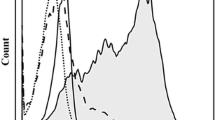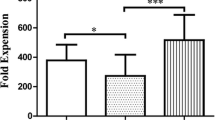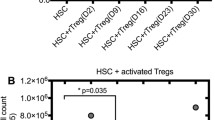Abstract
Cyclosporin A (CSA) is a widely used drug to prevent the immune cell function. It is well known that CSA blocks transcription of cytokine genes in activated T cells. The connection between T cells and CSA has been well established. However, the effect of CSA on natural killer (NK) cells is not thoroughly understood. Therefore, in the present study, splenocytes and peripheral blood mononuclear cells (PBMCs) were treated with CSA in the presence of concanavalin A (Con A) or interleukin-2 (IL-2). CSA at higher concentrations induces apoptosis and inhibition of proliferation, while lower concentrations showed synergistically enhanced proliferation in splenocytes and PBMCs. Further, CSA favored the in vitro conversion of CD3+CD161+ cells. Splenocytes and PBMC were found to have synergistic proliferation with Con A, and PBMC exhibited significantly higher expression of NKp30, NKp44, and granzyme B along with enhanced cytotoxicity against K-562 cells in CSA-treated animals. Proliferation assay also showed that proliferation of CD161+ cells was higher in CSA-treated animals. Collectively, our results suggest that CSA differentially influences the population, function, and expression of the NK cell phenotype.






Similar content being viewed by others
References
Kosugi A, Shearer GM (1991) Effect of cyclosporin A on lymphopoiesis. III. Augmentation of the generation of natural killer cells in bone marrow transplanted mice treated with cyclosporin A. J Immunol 146:1416–1421
Gummert JF, Ikonen T, Morris RE (1999) Newer immunosuppressive drugs: a review. J Am Soc Nephrol 10:1366–1380
Tedesco D, Haragsim L (2012) Cyclosporine: a review. J Transplant. https://doi.org/10.1155/2012/230386
Kosugi A, Sharrow SO, Shearer GM (1989) Effect of cyclosporin A on lymphopoiesis I. Absence of mature T cells in thymus and periphery of bone marrow transplanted mice treated with cyclosporin A. J Immunol 142:3026–3032
Kahan BD (1982) Cyclosporin A: a selective anti-Tcell agent. Clin Haematol 11:743–761
Gao EK, Lo D, Cheney R, Kanagawa O, Sprent J (1988) Abnormal differentiation of thymocytes in mice treated with cyclosporin A. Nature 336:176–179
Morris PJ, Chapman JR, Allen RD (1987) Cyclosporin conversion versus conventional immunosuppression: long-term follow-up and histological evaluation. Lancet 8533:586–591
Biron CA (1997) Activation and function of natural killer cell responses during viral infections. Curr Opin Immunol 9:24–34
Moretta A, Bottino C, Vitale M, Pende D, Migari MC, Biassoni R, Moretta L (2001) Activating receptors and coreceptors involved in human natural killer cell-mediated cytolysis. Annu Rev Immunol 19:197–223
Lanier LL (2008) Upon the tightrope: natural killer cell activation and inhibition. Nat Immunol 9:495–502
McNerney ME, Lee KM, Zhou P et al (2006) Role of natural killer cell subsets in cardiac allograft rejection. Am J Transplant 6:505–513
Palacios R (1982) Concanavalin A triggers T lymphocytes by directly interacting with their receptors for activation. J Immunol 128:337–342
Denyer MS, Wileman TE, Cartina MA, Zuber SB, Takamatsu H (2006) Perforin expression can define CD8 positive lymphocyte subsets in pigs allowing phenotypic and functional analysis of natural killer, cytotoxic T, natural killer T and MHC un-restricted cytotoxic T-cells. Vet Immunol Immunopathol 110:279–292
Eruslanov E, Kusmartsev S (2010) Identification of ROS using oxidized DCFDA and flow-cytometry. Methods Mol Biol (Methods and Protocols) 594:57–725
Wang H, Grzywacz B, Sukovich D, McCullar V, Cao Q, Lee AB, Blazar BR, Cornfield DN, Miller JS, Verneris MR (2007) The unexpected effect of cyclosporin A on CD56+CD16− and CD56+CD16+ natural killer cell subpopulations. Blood 110:1530–1539
Alamartine E, Sabido O, Berthoux F (1994) In-vitro effects of cyclosporin A, FK506, 6-mercaptopurine, and prednisolone on lymphokine-activated killer cells. Nephrol Dial Transplant 9:1456–1461
Macho A, Blanco-Molina M, Spagliardi P, Appendino G, Bremner P, Heinrich M, Fiebich BL, Munoz E (2004) Calcium inophoretic and apoptotic effects of ferutinin in the human Jurkat T-cell line. Biochem Pharmacol 68:875–883
Naujokat C, Daniel V, Bauer TM, Sadeghi M, Opelz G (2003) Cell cycle- and activation-dependent regulation of cyclosporin A-induced T cell apoptosis. Biochem Biophys Res Commun 310:347–354
Trinchieri GM, Matsumoto-Kobayashi SC, Clark J, Seehra L, London L, Perussia B (1984) Response of resting human peripheral blood natural killer cells in interleukin 2. J Exp Med 160:1147–1169
Biron CA, Young HA, Kasaian MT (1990) Interleukin 2-induced proliferation of murine natural killer cells in vivo. J Exp Med 171:173–188
Keskin DB, Allan DS, Rybalov B (2007) TGFbeta promotes conversion of CD16 + peripheral blood NK cells into CD16-NK cells with similarities to decidual NK cells. Proc Natl Acad Sci USA 104:3378–3383
Shin GT, Khanna A, Ding R (1998) In vivo expression of transforming growth factor-beta1 in humans: stimulation by cyclosporine. Transplantation 65:313–318
Minguillon J, Morancho B, Kim SJ, Lopez-Botet M, Aramburu J (2005) Concentrations of cyclosporin A and FK506 that inhibit IL-2 induction in human T cells do not affect TGF-beta1 biosysnthesis, whereas higher doses of cyclosporin A trigger apoptosis and release of preformed TGF-beta 1. J Leukoc Biol 77:748–758
Introna M, Allavena P, Spreafico F, Mantovani A (1981) Inhibition of human natural killer activity by cyclosporin A. Transplantation 31:113–116
Wai L, Fujiki M, Takeda S, Martinez OM, Krams SM (2008) Rapamycin, but not cyclosporin or FK506, alters natural killer cells function. Transplantation 85:145–149
Acknowledgements
This research was supported by Basic Science Research Program through the National Research Foundation of Korea (NRF) funded by the Ministry of Education (2017R1D1A3B03029075).
Author information
Authors and Affiliations
Corresponding author
Ethics declarations
Conflict of interest
These authors declare no conflict of interest.
Additional information
Publisher's Note
Springer Nature remains neutral with regard to jurisdictional claims in published maps and institutional affiliations.
Electronic supplementary material
Below is the link to the electronic supplementary material.
Rights and permissions
About this article
Cite this article
Adithan, A., John Peter, J.S., Hossain, M.A. et al. Biological effects of cyclosporin A on CD3−CD161+ and CD3+CD161+ lymphocytes. Mol Cell Biochem 458, 159–169 (2019). https://doi.org/10.1007/s11010-019-03539-2
Received:
Accepted:
Published:
Issue Date:
DOI: https://doi.org/10.1007/s11010-019-03539-2




